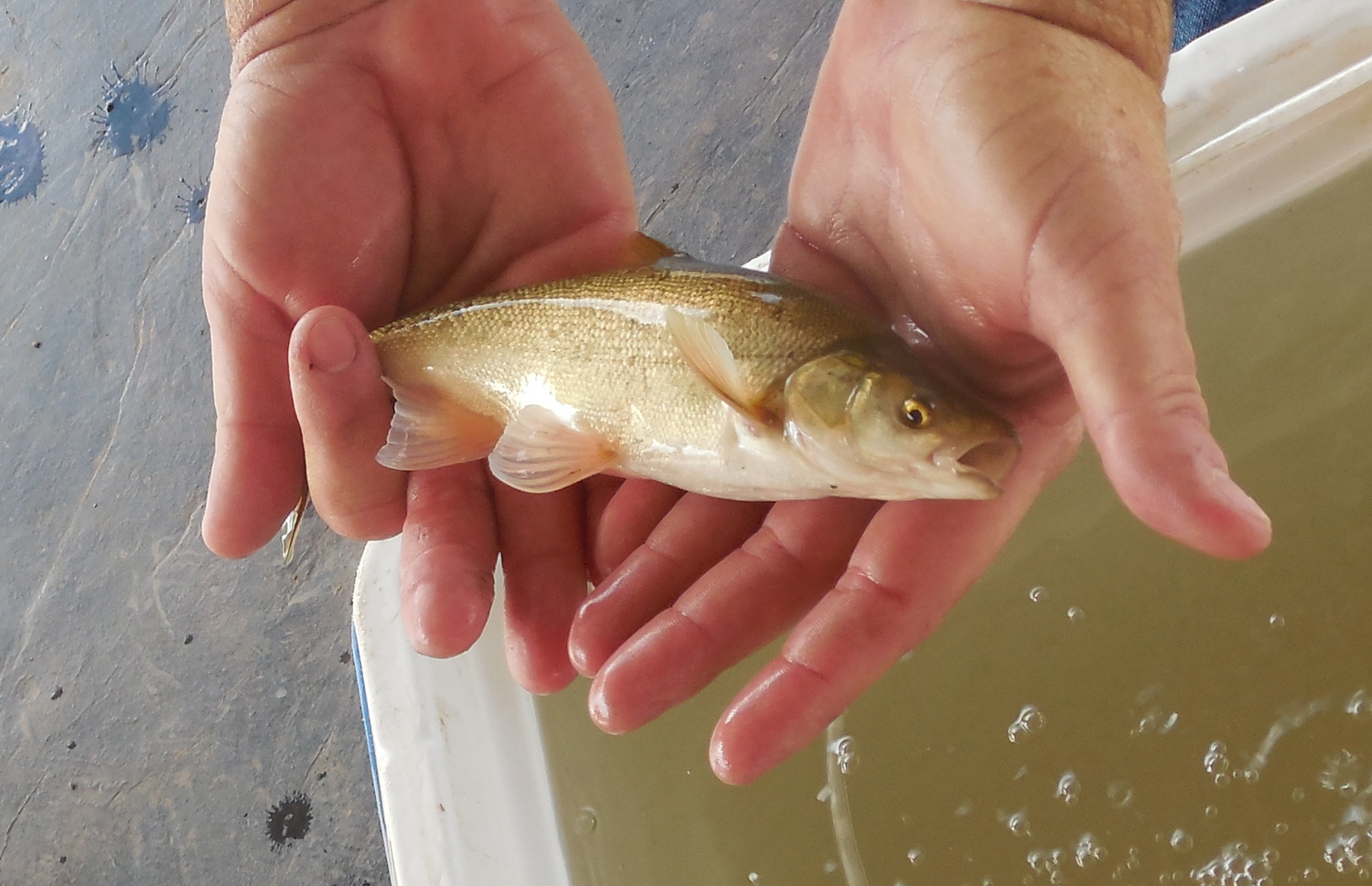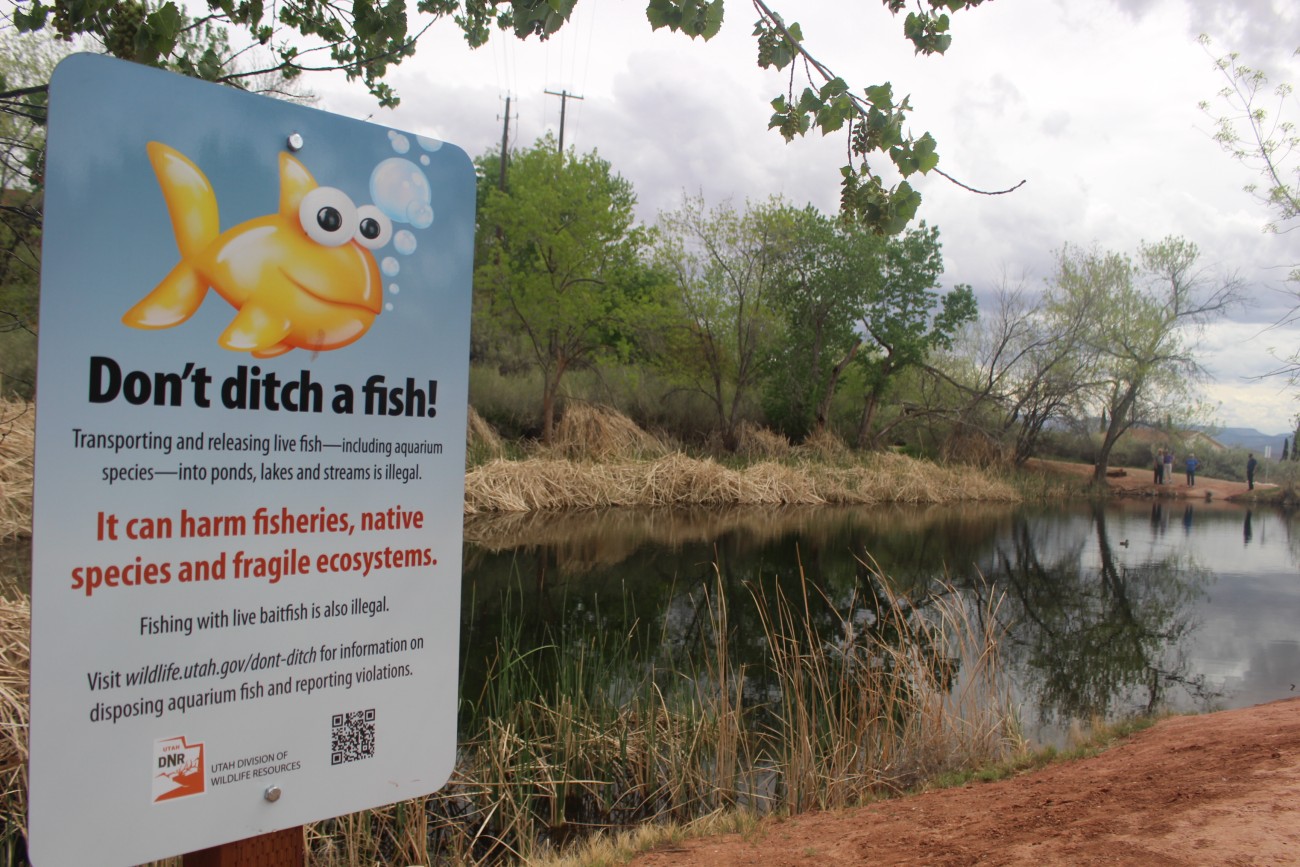Wildlife officials remind public not to 'ditch a fish' in local waterbodies - St George News
Wildlife officials remind public not to 'ditch a fish' in local waterbodies - St George News |
| Posted: 29 Apr 2020 06:01 AM PDT ST. GEORGE — Whether it's using a live non-native bait fish at a favorite fishing hole or just dumping an unwanted goldfish into the stream at the Red Hills Desert Garden, wildlife officials have a message for you: Don't do it.  Over the years non-native fish species have wreaked havoc on local reservoirs, fisheries and the Virgin River. According to the DWR, the problems the transplanted fish can create include outcompeting native fish for food sources, carrying parasites and pathogens that can harm native fish, preying on native fish and surviving and reproducing to the point of becoming an invasive species. Efforts to remove the invasive fish can cost tens of thousands of dollars and disrupt recreational use for long periods of time. "Just one released goldfish can have a big impact," said Melinda Bennion, a native aquatics biologist with the Utah Division of Wildlife Resources. The Utah DWR has worked to spread awareness about the risk of invasive species statewide for many years. Locally these efforts are aided through a partnership with the Washington County Water Conservancy District's Virgin River Program. The Virgin River plays host to various native fish that are listed as either endangered species or state-protected conservation species. Among those species are the woundfin, Virgin River chub and Virgin spinedace. In 2014, Arizona and Utah wildlife officials had to treat a 17-mile segment of the Virgin River due to the introduction of red shiners, a non-native bait fish that threatened the native woundfin species. Using live bait fish in Utah is also illegal. The red shiners are an example of a fish that would outcompete and out-reproduce the much rarer and endangered woundfin, said Steve Meismer, local coordinator of the Virgin River Program. One red shiner female can produce up to 10,000 offspring, he said. The chemical used to treat the river and kill off the red shiner is called rotenone. It is a natural product derived from the roots of South American plants and is specifically toxic to gilled organisms because it interrupts oxygen uptake from the water at the cellular level. It also completely decomposes without leaving any harmful residue.  Rotenone was most recently used on the Kolob Reservoir. In late 2018, three non-native species of fish – yellow perch, green sunfish and bluegills – were illegal stocked at the reservoir. This resulted in the reservoir having to be drained in addition to the chemical treatment. The reservoir was eventually refilled and restocked with fish by mid-2019. Similar incidents took place at Grandpa's Pond in Hurricane and Gunlock Reservoir in 2015 that required both bodies of water to be treated and drained. "That causes a reset of the whole fishery," said Christian Edwards, also a DWR native aquatics biologist. "It can take years for that to come back." An area that has been a popular fish-dump site is the Warms Springs pond in Washington City. Also known as the Boilers, the pond maintains a constant temperature of 70-75 degrees. Over the decades people have dumped not only their pet goldfish here but also more exotic fish like pacus and pet turtles. "That place has become an interesting menagerie over the years," Meismer said. Unlike other bodies of water, the introduced species at the Boilers have not been as big a concern, as they are largely contained to that area and do not pose a threat to the species of the Virgin River, Meismer said.  Another area hit with unwanted goldfish has been the stream at the Red Hills Desert Garden in St. George. The garden features a stream of Virgin River water that meanders through the garden and also serves as a home for some of the river's endangered and threaten fish species for educational purposes, and pet fish such as goldfish pose a serious problem. "Their reproductive capability is so great it can outcompete native fish," Meismer said. "They also eat the larva and eggs of native fish. It's the same thing that occurs everywhere else, and we've been dealing with the issue overall of the last 25 years." Getting rid of the invasive fish can be a pricey endeavor, Meismer said. Purging and treating the Red Hills Desert Garden of the unwanted fish in 2016 was estimated to run $10,000-$15,000. Treating a 30-mile stretch of the Virgin River can run up to $50,000, while dealing with reservoirs like Gunlock and Kolob can run as high as $100,000.  Those estimates do not include potential loss of revenue associated with the cessation of recreational use of the impacted areas during treatment. In order to help spread awareness of the threat and impact of invasive fish species, the DWR has created the "Don't ditch a fish" campaign. These efforts include signs warning of illegal fish dumping posted at various water bodies throughout the state. Those seeking help to properly dispose of aquarium species can contact the DWR for help. In addition to fish, the DWR and Virgin River Program have also had to deal with invasive vegetation and animal species such as bullfrogs and tree frogs. "That's one of our biggest issues," Edwards said. "People don't realize the threat they pose." There is also the persistent threat and continued boat inspection points for the invasive quagga mussel that can threaten water infrastructure and water-based ecosystems. The mussels are present and spreading in parts of Lake Powell with state and local water officials zealously working to keep the infestation contained. Copyright St. George News, SaintGeorgeUtah.com LLC, 2020, all rights reserved. |
| Posted: 22 Apr 2020 06:00 AM PDT Getting bored with the same old meals? It's been said that most households rely on the same 10 ingredients, rotating them for several dishes. Wake up the family with a dinner of octopus or crayfish. Or consider barramundi, an Australian sea bass similar to grouper. Loaded with healthy omega 3s, it's farmed in the waters Down Under, flash-frozen and available here with online orders from Euclid Fish Co. in Mentor. Many home cooks are intimidated by fish, but Terrie Young can help you out. She's the wife of Euclid Fish owner John C. Young and the mom of John V. and Charles Young, representing the fourth generation of the Young family to run the business. Even some who claim to not like fish find barramundi to be light and delicious. It's perfect in fish tacos, so today's recipe is sure to gather fans and requests for an encore on the next Taco Tuesday or any other time. Euclid Fish Co., in business for 76 years, continues to provide fish to area many markets, such as Heinen's. However, in keeping with the times, it has segued its retail business into a thriving carryout operation. Order from its website and include a pickup time, framed around lunch and dinner hours. Drive to its Mentor store, at 7839 Enterprise Drive, and call to let them know you've arrived. Your packaged order is brought out by a masked-and-gloved employee and loaded into your trunk. That employee is likely to be a John V. Young or another member of the same family, which began Euclid Fish back in the 1940s. His brother, Charles, lives in the Pittsburgh area, where his focus is developing business in western Pennsylvania. Terrie is chief developer of recipes.  Four frozen North Atlantic lobster tails are $41.99 and available for carryout. The Young clan and their Euclid Fish have helped feed the boom in Northeast Ohio clambakes each late summer and early fall. Many of the bakes served at restaurants and backyards originate with the company. "Because so many restaurants have closed, it's difficult to get wild fish because fishermen can't sell it and aren't going out as they did before COVID-19," said J.V., as John is known. "But the decades of relationships my family has developed allows us to get the best fish there is on the planet." Just before travel became difficult, he and his brother had gone to New Zealand to develop relationships with fish farmers there. Customers cruising the Euclid Fish website, efcmarket.com, often are astounded at the fish varieties to be found there. You'll find cod and salmon, of course, but also clams, walleye, perch, lobster, tilapia, shrimp, oysters, giant crab legs, swordfish, halibut, grouper and more. And it's a surprise to see steaks, chicken, veal, lamb, pork ribs and ground beef along with eggs and Ohio City Pasta in a fish market.  Fresh organic Norwegian salmon is packaged to go. "We're trying to serve our customers so they don't have to run all over town," said Terrie, explaining why toilet paper, paper towels and latex gloves also can be ordered on the website. They also have meals to take home — but for now only on Fridays. Tater tots smothered with peppered smoked salmon and cheddar cheese is the most popular item on the Market Menu, but other meals include seafood sandwiches and wraps, seafood tacos, a variety of tater tots, chicken, beef, dinners framed around cod, sole and shrimp plus pairing dinners for two. Besides toilet paper and paper towels, I also bought fresh organic Norwegian salmon and crawfish, just because I could. If I'd spent $200, I could have gotten doorstep delivery, but I was just there to grab provisions for a couple of dinners.  Fresh Norwegian salmon to go becomes salmon with shallots at home. I created a divine salmon sauced with shallots, tomatoes, and cream and poured a lovely Rhone to drink with it. The original recipe, which came from a favorite French chef in Provence, included basil and créme fraiche, but I was out of both so I substituted chopped parsley and heavy cream. A nice dry Rosé from Provence was poured with it in France, but all I had was a Rhone. The full-flavored salmon stood up well to this vigorous wine. |
| You are subscribed to email updates from "exotic fish" - Google News. To stop receiving these emails, you may unsubscribe now. | Email delivery powered by Google |
| Google, 1600 Amphitheatre Parkway, Mountain View, CA 94043, United States | |
Comments
Post a Comment